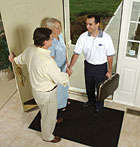
Some estimate that only 30 to 40 percent of the public knows about the transition to R-410A, so contractors need to fill in the knowledge gaps when discussing a new cooling system. (Photo courtesy of Carrier.)
Back in 2005 when Dan Kalman started educating consumers about the upcoming transition to R-410A, he didn’t find a very receptive audience. The problem at that time, noted the director of operations of Lee Co., Nashville, Tenn., was that R-410A was a lot more expensive than R-22, which made it difficult to convince customers to buy the pricier systems.
Complicating matters, said Kalman, was the fact that he did not feel the industry was providing a clear message that R-410A would be “the” refrigerant that would take the place of R-22. “We weren’t sure if they would try to come up with a drop-in replacement for R-22, so that was a bit of a challenge. Once the industry firmly stated that there would be no drop-in replacement and R-410A was the next-generation refrigerant, that made our lives much easier.”
Also making life easier was the onset of the green movement, which meant customers started asking for more information about environmentally friendly systems. Then the tax credits became available for high-efficiency R-410A equipment, and all of a sudden, talking to customers about the refrigerant transition became so much less complicated.
A PERFECT STORM
The green movement, the tax credits, and the now-comparable cost of R-410A and R-22 equipment are making for a perfect storm in the HVAC industry, said Chris Koehner, director of sales, Lee Co. “With the economy, people are being more responsible with their money. They’re thinking about the future, and they’re not moving, so they want better comfort in their homes. Right now, we’re in a really good place, all things considered.”Before all these opportunities came into play, Koehner noted he had his work cut out for him when it came to educating consumers about R-410A. “We focused on how the chlorine in the R-22 was damaging the ozone layer, but it was difficult to explain to a homeowner why one refrigerant was better than the other.”
Randy Imker, vice president/general manager, Flare Heating and Air Conditioning, Minneapolis, also focused on R-22 not being an ozone-friendly product when educating consumers about R-410A. “We tell consumers that R-410A does not deplete the ozone layer and that the high-efficiency units are only being manufactured with R-410A. If customers want high efficiency or an environmentally friendly system, they have to buy a R-410A unit.”
At first, it was more challenging to talk with customers about the more expensive R-410A equipment, said Imker, but he said it was not difficult to sell to people who wanted to be environmentally friendly or who wanted high efficiency. “You always have those customers who don’t want to pay a higher price. It was a little hard at first. Now in our add-on/replacement business, it’s very seldom that we would sell anything except R-410A.”
Customer awareness of the industry transition to R-410A still seems to be on the low side, so contractors need to be prepared to spend time educating consumers about the new refrigerant. Imker said that more people seem to have information about R-410A thanks to the Internet, but he still estimates that only 30 to 40 percent of the public knows about the phaseout of R-22.

Dan Kalman (left) and Chris Koehner have been educating customers about the transition to R-410A since 2005.
TAKING TIME TO TRAIN
To better educate consumers about R-410A, Kalman has made sure his technicians are prepared to handle any questions coming their way. “We do a lot of training, whether it’s in-house, at the distributor, or through the manufacturers. We feel that our guys cannot have too much training, especially going into this time when there’s so much change.”This training is particularly beneficial when a technician is in the field servicing an older R-22 unit, as this provides the perfect opportunity to talk to the homeowner about replacing the equipment with an R-410A system. Kalman noted that while his technicians do discuss this with homeowners, most usually wait until their systems fail before replacing the equipment. Those who do opt to replace their R-22 system with R-410A before it breaks down do so because they want to take advantage of the tax credit, obtain a better warranty, and enjoy higher efficiencies with an environmentally friendly refrigerant, said Kalman.

Educating consumers about R-410A usually involves explaining that the new refrigerant contributes to higher efficiency in equipment while not depleting the ozone layer. (Photo courtesy of Carrier.)
While it may take some time and effort to educate customers about R-410A, it is definitely worth the effort. As Kalman noted, smart contractors realize now is the perfect time to explain the benefits of R-410A to consumers. “We have some terrific opportunities right now. We’re in the middle of the refrigerant transition, which has caused an increased awareness of high-efficiency equipment. And the 30 percent tax credit is there, which encourages people to buy. All these changes are definitely strengthening our industry, in my opinion.”
Publication date:11/23/2009


Report Abusive Comment